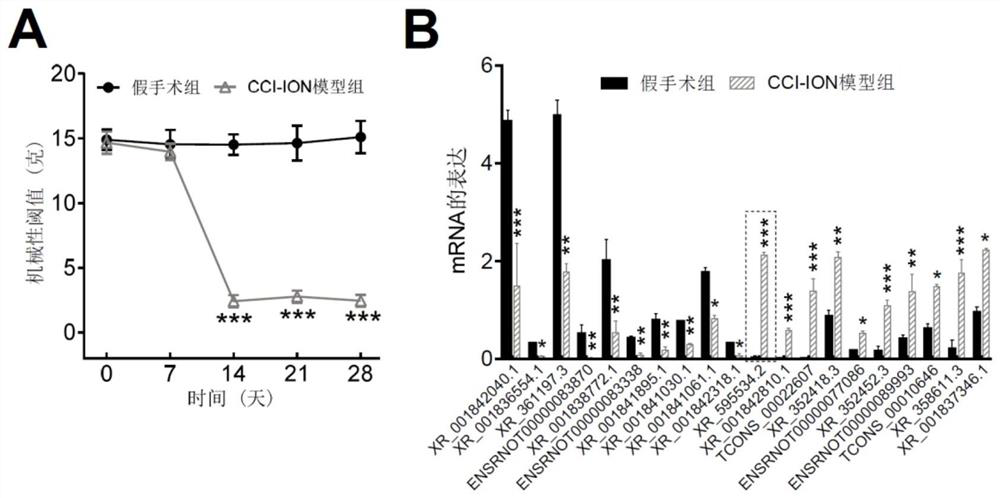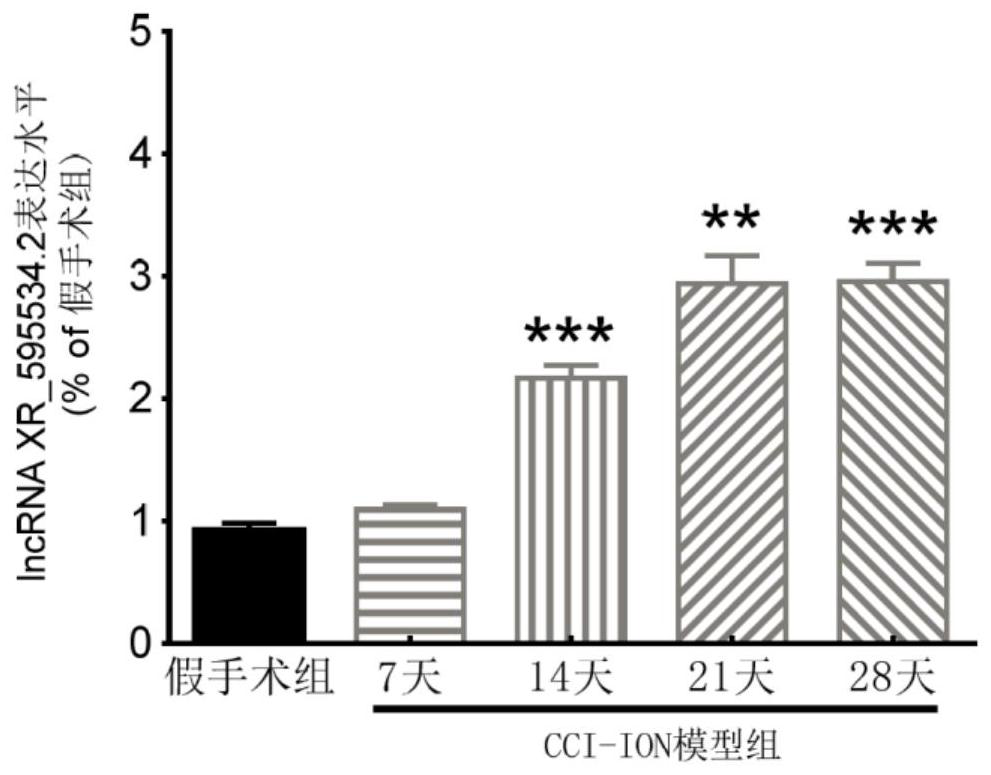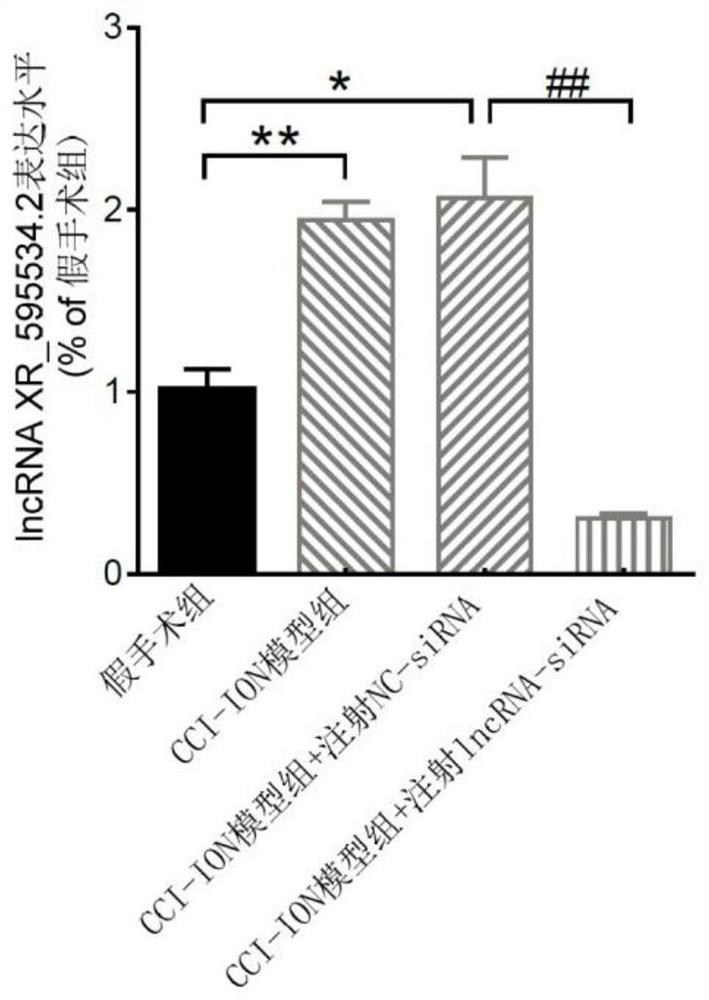Application of lncrna XR_595534.2 in the preparation of drugs for the treatment or prevention of chronic pain
A drug and trigeminal neuralgia technology, applied in the field of biotechnology and medicine, can solve the problems of prone to gastric bleeding, poor curative effect of chronic neuropathic pain, dependence and addiction, and achieve the effect of alleviating pain behavioral responses
- Summary
- Abstract
- Description
- Claims
- Application Information
AI Technical Summary
Problems solved by technology
Method used
Image
Examples
Embodiment 1
[0026] Example 1: High-throughput sequencing results show lncRNAs differentially expressed in TG tissues of CCI-ION model rats
[0027] (1) Infraorbital nerve chronic compression injury (CCI-ION) model
[0028] Adult male healthy Sprague-Dawley rats weighing 180–250 g were provided by the Experimental Animal Center of Soochow University. Sanitary approval document number of the Animal Center: SYXK (Su) 2007-0035. Before the experiment, the animals were allowed to adapt to the feeding environment for three days and underwent adaptive stimulation training. The model was established using routine laboratory practices: the rats were anesthetized by intraperitoneal injection of 4% chloral hydrate at a dose of 1 ml / 100 g, and the rats were fixed on the operating table in a supine position. The first molar level was incised with a sterile razor blade, and the surrounding tissue was carefully separated using a bluntly bent glass rod until the infraorbital nerve was exposed. The two...
Embodiment 2
[0034] Example 2: The expression of lncRNA XR_595534.2 in TG tissue of CCI-ION model rats was significantly increased by fluorescence quantitative PCR
[0035] (1) establishment of infraorbital nerve chronic compression injury (CCI-ION) model (same as embodiment 1)
[0036] (2) Real-time fluorescent quantitative PCR
[0037] RNA extraction: Rat TG was extracted using sterilized equipment, placed in a 1.5 ml sterilized centrifuge tube, 1 ml Trizol was added, the tissue was broken into a homogenate, and placed on ice for 30 minutes. Add 100 microliters of chloroform, and centrifuge in a centrifuge at 4 degrees and 12000 rpm for 20 minutes. Aspirate the upper aqueous phase into a new centrifuge tube, add an equal volume of isopropanol and place it in the refrigerator at -20°C for 20 minutes. Centrifuge at 12,000 rpm for 15 minutes at 4°C in a centrifuge, discard the supernatant, and add 75% ethanol to wash the precipitate. Centrifuge at 4°C at 7500 rpm for 5 minutes, discard the...
Embodiment 3
[0040] Example 3: siRNA interference sequence can effectively reduce the expression of lncRNA XR_595534.2 in TG of CCI-ION model rats
[0041] (1) RNA extraction (same as Example 2).
[0042] (2) Real-time fluorescent quantitative PCR (same as Example 2).
[0043] (3) Stereotaxic injection of siRNA interference sequence into rat TG: After the rat was anesthetized, it was fixed on the brain stereotaxic apparatus, and the scalp was incised with a scalpel. 2 o 2 The tissue is corroded, exposing the coronal and sagittal sutures. Use the point of intersection of the two, namely bregma, as the origin: bregma is 3 mm backward, 3 mm to the left of the midline, and 11.7 mm below the surface of the skull. Inject lncRNA XR_595534.2 siRNA (lncRNA-siRNA) and control siRNA (NC-siRNA) (purchased from Gemma Gene), the final injection concentration is 50 micromole / liter, and each rat is injected with 3 microliters, and the injection is completed in 5 minutes. Leave the needle for 10 minute...
PUM
 Login to View More
Login to View More Abstract
Description
Claims
Application Information
 Login to View More
Login to View More - R&D
- Intellectual Property
- Life Sciences
- Materials
- Tech Scout
- Unparalleled Data Quality
- Higher Quality Content
- 60% Fewer Hallucinations
Browse by: Latest US Patents, China's latest patents, Technical Efficacy Thesaurus, Application Domain, Technology Topic, Popular Technical Reports.
© 2025 PatSnap. All rights reserved.Legal|Privacy policy|Modern Slavery Act Transparency Statement|Sitemap|About US| Contact US: help@patsnap.com



